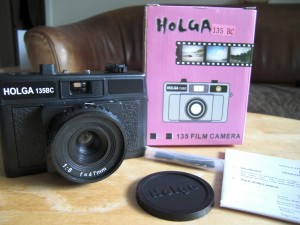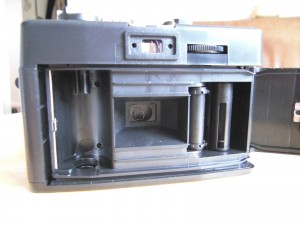
I’ve had my eye on this camera for a while – like every Holga Nut I imagine… who could resist the temptation of another Holga, especially if it’s different to the ones we know and love? Unlike its big brothers, this one takes standard 35mm film and produces 24x36mm negatives – easily processed on the High Street.
I rushed down to the Photographer’s Gallery last week to get the Holga 135BC, and I couldn’t wait to try it out. But before I show you the breathtaking results, here’s what this camera is all about.
There are two versions: the Holga 135 and the Holga 135BC. As I understand it, the only difference is a pink sticker on the BC version, and the fact that BC stands for “black corners”. This one should produce stronger vignetting, while the non-BC version shouldn’t.
Although there are no clues on the package or the manual, it’s fair to assume that this little baby is made by Tokina in Hong Kong, along with the rest of the fabulous Holga family.
What’s in the Box
We have the following ingredients at our disposal:
- 1x Holga 135BC (nice!)
- 1x Lens Cap with HOLGA written on it (I think all the new ones have that since 2008/2009)
- 1x pink box with example photos, a “drawing” of the camera featuring some monkey sticker. Note that the word “Holga” is written in a different font than what’s on the lens cap, the camera and previous boxes (I guess they’re not branding specialists – which makes it more attractive to me)
- 1x user manual
- and one of those hand straps that you *can* attach, although nobody in their right mind ever would
The Outside
Plastic. Cheap plastic, that’s what we like. But unlike his bigger brother, this one is really well built. The back doesn’t come off completely (it’s hinged, like on a proper camera). There’s a film counter on the top (just like on a proper camera), and the shutter button is at the top, not next to the side of the lens. Speaking of which, you can screw in a cable release for long exposures.
As for features, they’re almost identical to the 120 version: at the bottom, you’ve got a switch for “normal” and “bulb” settings, so double-exposures or as-long-as-you-press-the-button exposures are back with a vengeance. Of course there’s a standard tripod mount. Nice!
On the top there’s a hot shoe for an external flash, and we also have that notorious aperture switch. Just like the 120 version, it technically works, but both apertures are the same. Should make for easy modding I would hope. The lens barrel (if you want to call it that) has the same outer dimensions as the 120 version, so all accessories should fit like a glove. I love it when manufacturers do that!
The Inside

Under the hood, things look a bit different. The film winds from left to right, like on standard 35mm cameras. However, it unwinds counterclockwise (as determined by the cartridge), and winds into the camera clockwise. I’ve not seen that before! It’s a great idea though, because it makes the film less curly when you come to handle it for processing or scanning. If this is in fact the reason behind it, who knows.
Tha back pops open by lifting the film rewind knob. You wind the film with a wheel at the top right, like on a disposable. Film transport is done by a sprocket next to the film chamber, and a 1cm thick take up spool. All the components, like the rest of the camera, have a very sturdy feel to it.
If you look closely at the film chamber, you can see a translucent mask behind the lens that covers the corners – the responsible part for creating that great vignetting effect.
Lovely pictures. Does the lens need focusing or is it a fixed lens?
Thanks Crystal 😉
The lens is the same as on the original Holga so it needs focussing. There’s a distance scale of pictures on the lens barrel (i.e. 1 person = 1m, 3 people = 2-5m, 7 people and a mountain). It’s not an SLR so you have to guestimate the distance to your subjects. It’s all part of the Holga Experience 🙂
What a great set of pictures! Would you recommend the Holga 135BC or the Holga 120 CFN for a first-time Holga user?
Thanks Nina!
It depends a bit on your film processing budget. The 135BC takes 35mm film which makes it a bit cheaper when it comes to buying film and developing. The 120 CFN takes medium format, so your film will cost a bit more. Developing 120 film can be a bit difficult depending on where you live. The Lomo stores do it, so do professional labs. High Street chains foten have to send it away and it can be costly. If you’re developing and scanning yourself 35mm and 120 will cost you pretty much the same.
So I suppose my answer in short would be: go with the 135BC, and once you fall in love with it have a go at the 120 CFN 😉
Great pics. Firstly, when you said you got the grainy photos with a higher iso, do you mean you took a photo on a sunny day and used a high iso that is normally used at night instead of a low one for sunny weather? also i have been researching and like the pinhole versions cause of their range of depth. But sometimes i cant tell, what is the real difference between pinhole and lense and what are there pro’s and con’s? last thing, with the lense holga’s where you have the focus settings, what if you want to take a photo of lets say a street that has things all ranges away from the camera? thanks heaps, i appreciate it!
I used a high ISO film in rather overcast weather. High ISO in sunny weather without an ND filter would result in very overexposed pictures.
The Pinhole Holgas don’t actually have a lens – it’s only a very small “pinhead-sized hole” at the front which creates the picture. The smaller the hole, the sharper the picture. I think it’s the equivalent of shooting with an aperture of f197.
I never got into Pinhole Photography but I hear it can be quite fascinating. The downside here is that you always need to rest the camera on a tripod or a table because your exposure times will have to be between 2 and 30 seconds to get a picture. The fascinating bit is that you’re going back to the very beginnings of photography, and like you mentioned, get a massive depth of field.
The focus setting on the “normal” Holgas works just like on ordinairy cameras: say you take a picture of something about 3ft away and guestimate the distance correctly, you’ll get slightly a slightly blurred background in the distance. Likewise, if you’re focussing on infinity and have a close object in shot, the latter will be out of focus. The only remedy to get all these things in focus would be to shoot at a smaller aperture (which means modifying your Holga), or to focus on something in between.
It’s a trial-and-error experience – give it a try with a normal Holga first I’d suggest. It’s very rewarding and highly addictive 😉
HI Jay
I just bought my Holga BC as well ,i loaded the film and it wind but still the counter did’t change at all at ‘S’…anyhow i manage to bring this camera to a old town call ‘Melaca’ for a weekend trip.
Film still not finish but i do hope that everything is capture..
Gooc luck, I hope that film comes out! Let us know where we can have a look at your output 😉
I’m about to buy holga camera for myself. would you recommend 120GCFN or 135BC TLR? thanks so much!
Hi Luna,
I didn’t know that the 135BC was available as a TLR. It’s a tough one to answer. If you’re starting out, and if you’re likely to use a photo lab to process your films, you’re probably better off going for the 135BC instead of the 120 – it gives you a good feel and keeps film processing costs down.
However, the Holga 120 give syou much funkier pictures, better vignetting, light leaking capabilities and of course the “classic Holga feel”. It’ll cost you more to buy and process films though.
Hi Jay,
I’m so happy to have found your blog…I LOVE IT !! It has lotsa useful info in it…especially for a newbie like me, who is just thinking of buying myself a HOLGA.
I wantedto buy a 135bc, considering me as a newbie, but then I saw an online shop who sells 135BCTLR, with these specification:
-Glass Optical Lens, f/8 47mm
-Leaf Shutter, speed 1/100 sec
-135 Format Color or Black/White film
-ASA 100/ISO 21 or ASA 400/ISO 27 speed
-Eye level & Waist level finder
-Adjustable focusing
-G.N. of Flash: 12 (ASA 100/DIN 21, m)
-Hot Shoe for External Flash
-Size: 122x 118x 69.5mm
-Weight: 230g
it is a lil bit more expensive than the 135BC, but not much different.
so I would like to ask 4 your opinion and advices, since I cant seem to decide which to buy..
thank u vr much !
Hi Jessica,
thank you so much for your lovely comment 🙂
Wow that Holga is one I’ve not heard of yet – but by the sound of it could be rather exciting! More TRL fun to play with. If you go for it, you’ll have a very different picture taking experience than with ordinairy viewfinder Holgas.
I’ve had great fun with my 120 GTLR. I have noticed however that the “sports finder” as they call it (to take pictures the “viewfinder way”) isn’t worth paying attention to, even less so than normal Holga veiwfinders. It’s just a sqaure hole in the back.
The glass lens is supposed to take sharper pictures, but compared to the plastic versions I don’t see a big difference.
Show us some pictures from this camera when you get it 😉
hi jay,
im considering buying a holga and wanted one with 35mm film just to begin with so i can get them developed fairly easily. was wondering what you would recommend for a have-a-go photographer? i was thinking either the 135bc or the Diana.
also on the 135bc how do you know when to stop winding the film and have you found a flash to be necessary?
great to find help with this much depth.
thanks man
samuel
Hmmm… tricky one! I'd say go with the Holga 135BC – it's more like a "pure plastic toy" without the marketing budget and glossy brochure attached (which you'll get with the Diana, but you'll pay for it).
The Diana Mini is great, and it has very different features – but you'll need a special adaptor for the flash, whereas the Holga takes a standard one. Keeps the price down, unless you're going for the Diana Mini plus Flash package (which I'd recommend over the non-flash package).
Speaking of flash: definitely recommended indoors on both cameras. Outdoors you're OK during daylight and sunshine, but beware of dark images during dusk/dawn or overcast days.
The Holga 135BC will automatically stop in the right position when you forward the film and has a proper film counter.
Hope this helps 😉
brilliant. thanks man. on my way.